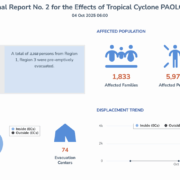Not a ‘free’ mealbut a lifeline

In the Philippines, which has one of the highest rates of stunting in children under five years old at 26.7 percent—higher than the global average of 22.3 percent—chronic hunger is a problem that threatens future generations.
According to the United Nations Children’s Fund (Unicef), around 18 percent of children in the Philippines, or about 2 million, are severely “food poor.” This not only points to a lack of calories but a deficiency in nutrients crucial to children’s growth and development.
Last July, Sen. Francis “Kiko” Pangilinan filed a bill seeking to address this problem by providing all public school learners from daycare centers, kindergarten to Grade 12 with fortified meals for breakfast directly sourced from the produce of local farmers and fisherfolk.
These meals could provide a lifeline for these poor children. They are not mere “ayuda” nor “free food,” but they create ripple effects on children’s health, well-being, and learning abilities.
Many countries have launched successful feeding programs: Thailand’s school lunch program, which is similar to Pangilinan’s measure, has reduced malnutrition and improved academic performance; South Korea’s free school meal program introduced in the early 2010s has been credited for significantly reducing behavioral issues in schools; and Brazil’s national school feeding program has been used as a benchmark for similar programs.
National feeding program
The country has a national feeding program policy under Republic Act No. 11037, but its scope is limited to undernourished children in daycare, kindergarten up to Grade 6. The Pangilinan proposal would expand the coverage up to Grade 12 and hit two birds with one stone: feed poor students and support local farmers and fishermen.
In its Year Two Report published last year titled “Fixing the Foundations: A Matter of National Survival,” the Second Congressional Commission on Education (Edcom II) underscored the role of nutrition and feeding as the foundation of quality education.
The commission acknowledged that the Philippines has made strides in improving the well-being of Filipino children in recent years.
“(However), millions of Filipino children remain chronically malnourished, facing challenges such as poor health, inadequate nutrition, and limited learning capacity,” it stated, noting that one in four Filipino children under five years old still experiences stunting.
Social inequity
In August, the Catholic Bishops’ Conference of the Philippines (CBCP) backed Edcom II’s call to government agencies, legislators, and local government units to take immediate action. It said undernutrition and malnutrition are a stark manifestation of social inequity, where only 25 percent of Filipino children aged six to 12 months meet the recommended energy intake; the rest were deficient in protein and healthy fats, essential for their physical growth and development.
“Socioeconomic disparities further exacerbate these challenges, limiting many children’s access to essential early childhood care and development services. These inequities hinder their ability to achieve optimal health, learning, and productivity outcomes,” Edcom II said.
It added that addressing these disparities demands a comprehensive approach that integrates quality early childhood education, health, and nutrition programs.
The CBCP cited the grim consequences: 48 percent of Grade one to three students are not prepared for their grade level, 80 percent of Grade three students struggle with multiplication, division, and geometry, and 30 percent are not functionally literate.
Global labor market
This has manifested in the Philippines’ poor performance in the 2022 Programme for International Student Assessment (Pisa), where it ranked 76th out of 81 participating countries in reading, math, and science.
This would have a severe impact on the competitiveness of younger generations in the global labor market, which puts a premium on a higher skill set.
Pisa noted: “Raising quality of education and protecting health, especially in the early years, will equip the next generation with the skills they need to meet the demands of higher productivity and higher paying jobs. Investing in the skills of this young population is essential to fuel future growth and increase household incomes.”
Without institutional help, however, poor Filipino children will be trapped in an endless cycle of poverty.
While a “free meal” may be inconsequential to others, it represents a lottery ticket to many poor Filipino families that could help them escape poverty.
If the government wants to invest in the country’s future, it must help children reach their full potential as adults. To do this, it must ensure that no hungry child is left behind.

















Faith, violence, protest in a fragmented world